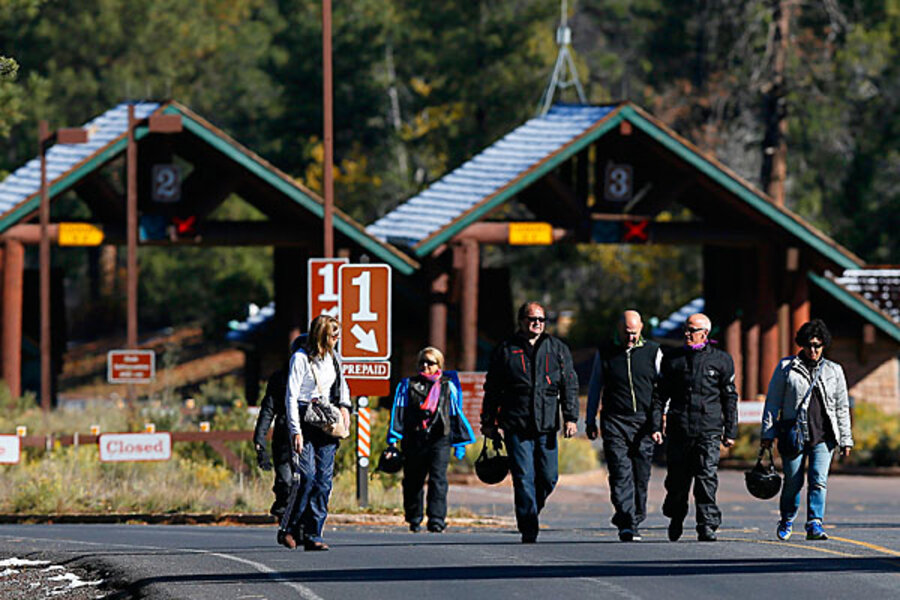Government shutdown defied: Grand Canyon reopens, for a week
Loading...
| Flagstaff, Ariz.
The trains are rolling in, tour buses are pulling up and vehicles are moving steadily through the entrance gates of Grand Canyon National Park after Arizona struck a deal with the federal government to reopen the landmark tourist area.
"Y'all come back to the Grand Canyon, it's open," Gov. Jan Brewer said Saturday from the South Rim.
Park employees who had been furloughed because of the federal budget battle awoke early Saturday to remove closure signs from trails, unlock restrooms and restock shelves before allowing vehicle traffic. Arizona is paying the National Park Service $651,000 to keep the Grand Canyon open for seven days.
Joe Del Monte and his wife planned a trip to the Grand Canyon for their children's mid-winter break. He kept their hotel reservations in Tusayan, just outside the South Rim entrance, while they visited Sedona, holding out hope that his son's wish to throw a stick into the Grand Canyon would be fulfilled.
"It was a bit of disbelief that they could close a place like the Grand Canyon," said Del Monte, of Chandler. "We're grateful politics got pushed to the side."
The family planned to do some hiking and "soak in as much as possible and enjoy the nice weather."
The Grand Canyon typically gets 18,000 visitors a day in October at a time when temperatures are cooler and the leaves begin to change colors.
The partial government shutdown ruined vacations and threatened businesses that depend on Grand Canyon tourism. Federal and private employees were furloughed, river rafting trips canceled, and campgrounds, hotels and hiking trails closed. Officials estimate losses in the millions.
Services to visitors were expected to be limited during the first 48 hours as vendors restock. The first meal at El Tovar Hotel on the South Rim was planned for Saturday night.
The funding to reopen the park came from the state Office of Tourism, the town of Tusayan and private businesses. Tusayan Mayor Greg Bryan presented a check for $426,500 to Brewer during a Saturday news conference.
Grand Canyon Superintendent Dave Uberuaga said the long weekend was a major driver in talks to resume park operations. He said the agreement with Arizona includes an option to extend the opening of Grand Canyon past seven days if needed.
"It's going to be a significant economic boost to everybody," he said. "Hopefully, we can have a continuing resolution by the time we run through the state of Arizona agreement and their funding."
The reopening of the Grand Canyon Saturday and the Statue of Liberty Sunday, are part of what some experts are saying is a symbolic of repudiation by regular Americans of Washington gridlock, including Republican and Democratic leadership, reports The Christian Science Monitor.
Though the federal government is giving up no control of the parks, the decision by states to take charge in order to reopen the parks drew parallels to the simmering Sagebrush Rebellion in the West, where elected officials have long schemed to annex federal lands back into state hands.
“It’s no surprise that the parks became very visible symbols of the consequences of this kind of shutdown, giving us both a teachable moment for people to realize that government does stuff that they like, but where we also saw fundamental manipulation going on,” says John Freemuth, a political scientist at Boise State University and a former Park Ranger.
Other national parks and monuments in Arizona remain closed. The exception is Glen Canyon National Recreation Area, which stretches into Utah. Utah governor Gov. Gary Herbert sent $1.67 million to the U.S. government to open the recreation area that includes Lake Powell, and other sites in Utah.
Brewer said she would push Congress to reimburse Arizona for funding the Grand Canyon.
"Arizona should not have to pay the federal government's tab here," she said. "It's their responsibility. The president and Congress should get up and do their jobs and negotiate an end to this shutdown as soon as possible."
Copyright 2013 The Associated Press. All rights reserved. This material may not be published, broadcast, rewritten or redistributed.





